In the structure of commercial treadmills, although running belts and running boards may seem ordinary, they have a crucial impact on the user’s exercise experience and safety.
Let’s start with the running belt. It is a component that runners come into direct contact with, and its quality and performance are directly related to the smoothness and comfort of running. The running belts of commercial treadmills are generally wide, with common widths ranging from 45 to 65 centimeters, or even wider. The wider running belt provides runners with a broader space for movement, reducing the risk of foot restrictions and falls caused by a too narrow running belt. It is especially suitable for people of different body types and running habits.
The material of the running belt is also very crucial. High-quality running belts usually adopt a multi-layer structure, including wear-resistant layers, cushioning layers, and anti-slip layers, etc. The wear-resistant layer can resist long-term friction and extend the service life of the running belt. The buffer layer can absorb the impact force during running and reduce the pressure on the joints. The anti-slip layer ensures the safety of runners during exercise and prevents injuries from slipping on the soles of their feet. In addition, the flatness and stability of the running belt should not be overlooked.

If the running belt deviates or shakes during operation, it will not only affect the running experience but also may damage other components of the treadmill. The running board is also an important part that cannot be ignored. The thickness and material of the running plate determine its buffering performance and durability. Generally speaking, the thickness of the running board of commercial treadmills is around 20 to 30 millimeters. Thicker running boards can provide better buffering effects and effectively reduce the damage to joints such as knees and ankles caused by the impact force generated during running. The materials of the running board are mostly high-density fiberboard or solid wood. These materials have good strength and stability, and can withstand considerable pressure and frequent use.
Meanwhile, some high-end commercial treadmills also adopt special treatment processes on the surface of the running board, such as adding textures or coatings, to increase friction and enhance the safety of running. The maintenance of running belts and running boards is also very important. Regular cleaning of the running belt and running board to remove dust, sweat and other stains can prevent corrosion and damage to the material. At the same time, it is necessary to pay attention to checking the tension of the running belt and the flatness of the running board. If any abnormality is found, it should be adjusted and repaired in time. When choosing a commercial treadmill, it is essential to carefully examine the quality and performance of the running belt and running board. High-quality running belts and running boards not only provide users with a comfortable and safe exercise experience, but also extend the service life of the treadmill and reduce the cost of use.
Post time: Aug-01-2025


